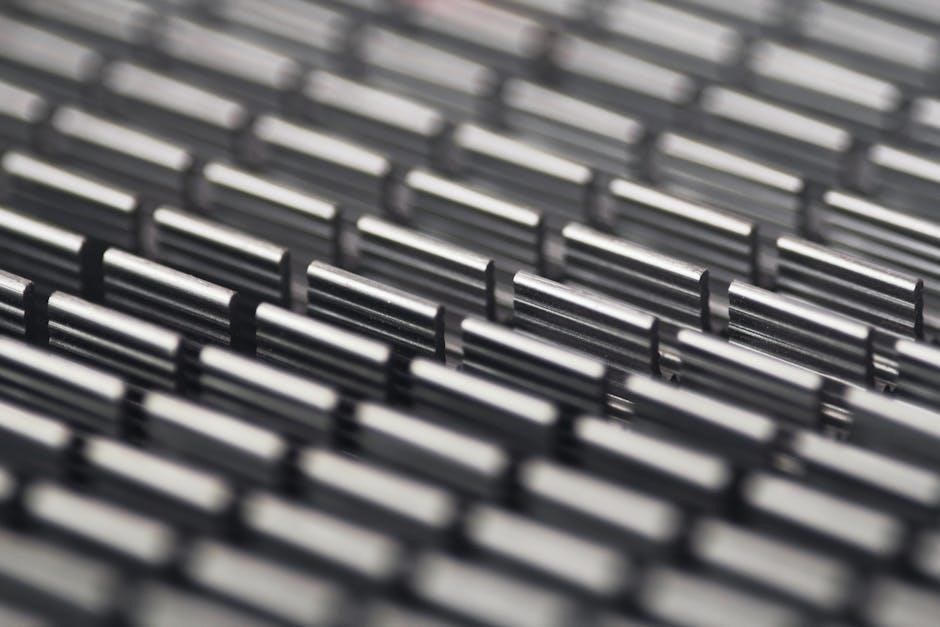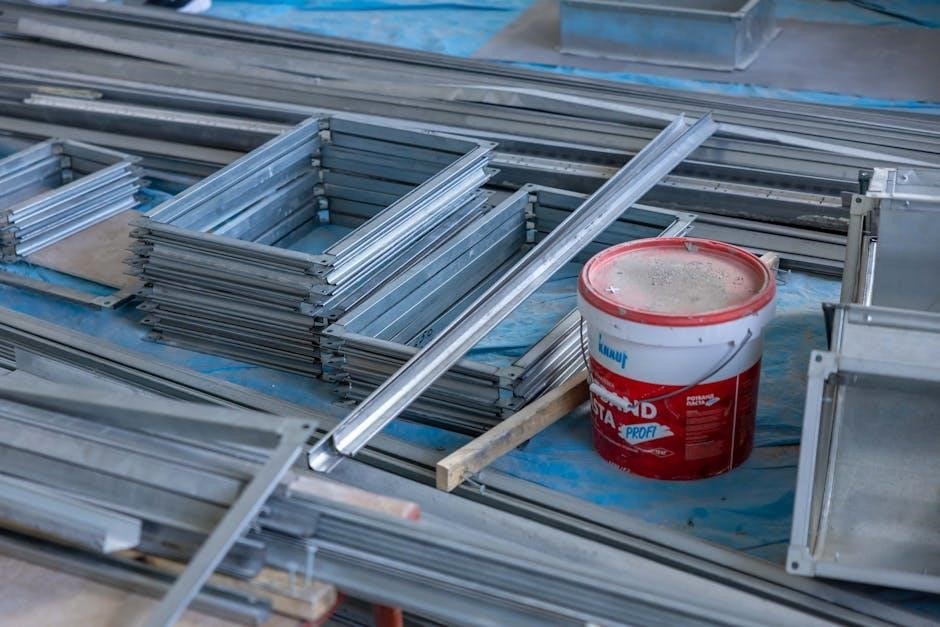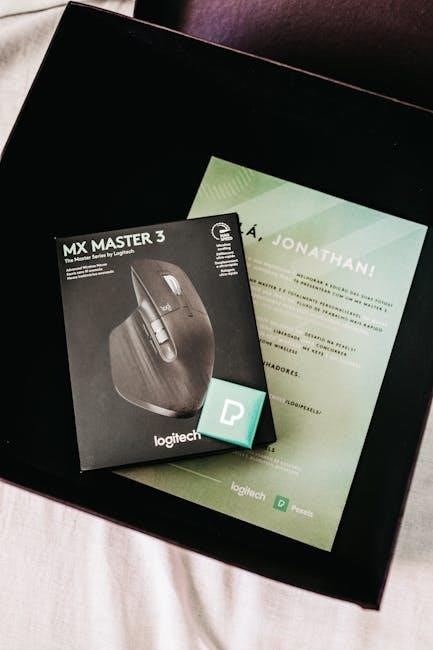Adhesive joining of structural components involves bonding materials using specialized adhesives, offering enhanced durability, weight reduction, and design flexibility. It is an innovative yet challenging technique.
1.1 Historical Development and Significance
Adhesive joining has evolved significantly over centuries, with early applications using natural substances like tar and plant resins. The 20th century saw the rise of synthetic adhesives, revolutionizing industrial practices. By the mid-1900s, adhesive bonding became integral to aerospace and automotive industries, enabling lightweight, durable structures. Historical advancements in materials science and manufacturing processes have shaped its significance, offering alternatives to traditional welding and mechanical fastening. This evolution underscores adhesive joining’s role in modern engineering, driving innovation in structural design and performance across diverse sectors. The historical development highlights its adaptability and growing importance in addressing contemporary challenges in materials assembly.
1.2 Current Trends and Challenges
Current trends in adhesive joining emphasize advancements in high-performance adhesives, improved surface preparation methods, and hybrid techniques combining adhesives with mechanical fastening. Innovations like solvent-free and eco-friendly adhesives are gaining traction, addressing environmental concerns. Localized spot joining and non-destructive testing (NDT) technologies are also emerging, enhancing precision and quality assurance. However, challenges persist, such as ensuring long-term durability and adhesion in harsh environments. Additionally, the development of inspection methods for bond quality remains a critical issue. Balancing performance, sustainability, and cost-effectiveness is essential to overcoming these challenges and advancing the technology. These trends and challenges highlight the dynamic evolution of adhesive joining in modern engineering applications.

New Insights in Adhesive Joining Technologies
Emerging technologies in adhesive joining focus on advanced materials, surface treatments, and hybrid techniques, offering improved strength, durability, and sustainability for modern structural applications.
2.1 Advanced Adhesive Materials and Formulations
Recent advancements in adhesive materials have led to the development of high-performance formulations, such as epoxy-based and polyurethane adhesives, offering improved thermal stability and flexibility. These materials are engineered to enhance bonding strength and durability in demanding environments. Solvent-free adhesives, like the 9501-F curing adhesive, are gaining traction due to their eco-friendly properties and ability to replace traditional solvent-based systems. Innovations in polymer chemistry have also enabled the creation of hybrid adhesives that combine the benefits of multiple materials. These formulations are tailored to specific applications, ensuring optimal performance in multi-material structures. Such advancements are critical for industries requiring lightweight, high-strength solutions, making adhesive joining more viable for complex engineering challenges.
2.2 Surface Preparation Methods for Enhanced Adhesion
Surface preparation is critical for achieving strong, durable bonds in adhesive joining. Traditional methods like grit blasting and chemical etching remain widely used to enhance surface roughness and remove contaminants. However, advancements have introduced more precise techniques, such as laser surface treatment and plasma activation, which provide controlled surface modification. These methods improve wettability and chemical bonding by increasing surface energy. Innovations in cleaning technologies, including ultrasonic and vacuum-based systems, ensure higher cleanliness levels. Additionally, eco-friendly alternatives to hazardous chemicals are being developed to align with sustainability goals. Proper surface preparation not only strengthens adhesion but also reduces the risk of premature failure, making it a cornerstone of reliable structural bonding.
2.3 Hybrid Joining Techniques: Combining Adhesives with Mechanical Fastening
Hybrid joining techniques integrate adhesive bonding with mechanical fastening, such as riveting or bolting, to create high-performance joints. This approach combines the uniform stress distribution of adhesives with the localized strength of mechanical fasteners, enhancing overall joint integrity. By addressing the limitations of each method alone, hybrid techniques improve resistance to fatigue, environmental factors, and dynamic loads. They are particularly advantageous in complex assemblies where mixed-material bonding is required. Recent advancements have optimized hybrid systems for applications in automotive and aerospace industries, offering improved strength, durability, and reduced weight. This innovative approach ensures higher reliability and longevity in structural components, making it a key area of focus in modern manufacturing.

Emerging Technologies in Structural Bonding
Emerging technologies in structural bonding focus on innovative materials and methods to enhance efficiency and sustainability, addressing challenges in bonding large-scale components while ensuring precision and durability.
3.1 Solvent-Free and Eco-Friendly Adhesives
The development of solvent-free and eco-friendly adhesives represents a significant advancement in structural bonding. These adhesives eliminate volatile organic compounds (VOCs), reducing environmental impact and improving workplace safety. Innovations like the 9501-F curing adhesive, a one-component acrylated urethane, offer high performance while being solvent-free, making them ideal for replacing traditional epoxy urethane and silicone materials. This shift supports sustainable manufacturing processes, aligns with global environmental regulations, and addresses the demand for greener technologies. Such adhesives are particularly beneficial for industries like automotive and aerospace, where reducing emissions and waste is critical. Their adoption not only enhances bonding quality but also contributes to a more sustainable future in structural component assembly.
3.2 Localized Spot Joining for Large-Scale Components
Localized spot joining is an innovative technique optimized for bonding large-scale structural components. This method allows for precise, targeted adhesion in specific areas, ensuring strong and durable joints without unnecessary material usage. It is particularly effective for 2D structures and large-scale applications, where traditional bonding methods may lack efficiency. By focusing on localized spots, this technique enhances production speed and reduces material waste. Awais Awan highlights its suitability for large components, emphasizing the precision achieved in spot joints. This approach is especially valuable in industries requiring efficient assembly of oversized parts, offering both cost-effectiveness and improved bonding performance. Localized spot joining is a step forward in addressing the challenges of scaling up adhesive bonding technologies.
3.3 Non-Destructive Testing (NDT) for Bond Quality Assurance
Non-Destructive Testing (NDT) plays a crucial role in ensuring the quality and reliability of adhesive bonds in structural components. Advanced NDT techniques, such as ultrasonic testing, acoustic emission, and infrared thermography, allow for the detection of defects or weak points in the bond without damaging the components. These methods are essential for verifying the integrity of large-scale or complex joints, where traditional inspection methods may fall short. The latest advancements in NDT technologies enable precise monitoring of bond quality, ensuring adherence to high-performance standards. This is particularly critical in industries like aerospace and automotive, where failure of structural bonds could have severe consequences. NDT ensures that adhesive joints meet rigorous safety and durability requirements, making it a cornerstone of modern bonding technologies.

Applications Across Industries
Adhesive joining is essential across automotive, aerospace, construction, and maritime industries, enabling lightweight, durable, and complex structures that enhance performance and efficiency in diverse applications;
4.1 Automotive and Aerospace Engineering
Adhesive joining is pivotal in automotive and aerospace engineering, enabling the creation of lightweight, high-performance structures. In automotive manufacturing, adhesives are used to bond dissimilar materials, reducing weight while maintaining strength, which enhances fuel efficiency. Similarly, in aerospace, adhesive bonding is critical for constructing aircraft and spacecraft components, ensuring durability under extreme conditions. The technique allows for the integration of advanced materials like fiber composites and metals, enabling complex geometries that cannot be achieved with traditional welding. Hybrid joining methods, combining adhesives with mechanical fastening, further improve joint properties, making them ideal for dynamic load environments. These innovations are driving advancements in both industries, fostering efficiency and reliability in modern vehicles and aircraft.
4.2 Construction and Civil Engineering
Adhesive joining plays a transformative role in construction and civil engineering, enabling the bonding of diverse materials like concrete, steel, and composites. This technique enhances structural integrity and simplifies construction processes, particularly in large-scale projects. Recent advancements, such as solvent-free adhesives and localized spot joining, address the unique challenges of bonding in civil engineering, ensuring durability and minimizing environmental impact. Hybrid joining methods, which integrate adhesives with mechanical fastening, offer robust solutions for structures like bridges and high-rise buildings, where strength and stability are paramount. These innovations are revolutionizing construction practices, providing efficient and reliable alternatives to traditional methods, and paving the way for more sustainable and resilient infrastructure in the future.
4.3 Maritime and Advanced Manufacturing
Adhesive joining is increasingly vital in maritime and advanced manufacturing, enabling the construction of lightweight, durable, and corrosion-resistant structures. In shipbuilding, adhesives are used to bond fibre-reinforced composites and steel, reducing weight while maintaining strength. Advanced manufacturing benefits from localized spot joining, which is ideal for large components, ensuring precision and efficiency. Hybrid techniques, combining adhesives with mechanical fastening, address the challenges of bonding dissimilar materials. These innovations are critical for producing high-performance maritime vessels and complex industrial systems. Collaborative efforts between industry and research institutions are driving the development of eco-friendly and high-strength adhesives, enhancing the sustainability and reliability of maritime and manufacturing applications. These advancements are reshaping the future of both industries, enabling the creation of innovative, high-performance products.

Future Directions and Innovations
Innovative approaches in adhesive technologies are driving advancements, with a focus on sustainable and smart solutions that enhance performance and open new possibilities for structural applications across industries.
5.1 Research and Development in High-Performance Adhesives
Research in high-performance adhesives focuses on advancing polymer chemistry and nanomaterials to create stronger, more durable bonds. Innovations include solvent-free and eco-friendly formulations, reducing environmental impact while enhancing adhesive properties. Smart adhesives with adaptive capabilities are being developed to respond to environmental changes, offering real-time monitoring and self-healing features. These advancements aim to meet the demands of industries like aerospace and automotive, where lightweight and high-strength materials are critical. Sustainable practices in adhesive production align with global environmental goals, ensuring a greener future for structural bonding technologies.
5.2 Sustainability and Environmental Considerations
Sustainability has become a focal point in adhesive joining technologies, with a growing emphasis on eco-friendly formulations. Solvent-free adhesives are gaining traction, reducing volatile organic compounds (VOCs) and minimizing environmental impact. Researchers are exploring bio-based adhesives derived from renewable resources, offering a greener alternative to traditional materials. Additionally, efforts to improve recycling and reuse of bonded components are underway, aligning with circular economy principles. Lifecycle assessments of adhesives are also being conducted to evaluate their environmental footprint. These initiatives aim to balance performance with sustainability, ensuring adhesive joining technologies contribute to a more eco-conscious future across industries.
5.3 Smart Adhesives and Adaptive Bonding Systems
Smart adhesives and adaptive bonding systems represent a cutting-edge advancement in adhesive joining technologies. These systems integrate intelligent materials that can respond to environmental changes, such as temperature or stress, ensuring optimal bonding performance. Self-healing adhesives are a key innovation, capable of autonomously repairing minor damages to maintain bond integrity. Additionally, these systems often incorporate sensors that monitor bond health in real-time, enabling predictive maintenance and enhancing reliability. Adaptive bonding technologies also allow adhesives to adjust their properties dynamically, improving their compatibility with diverse materials and operating conditions. Such innovations are particularly valuable in industries like aerospace and automotive engineering, where real-time monitoring and adaptability are critical for safety and performance.
